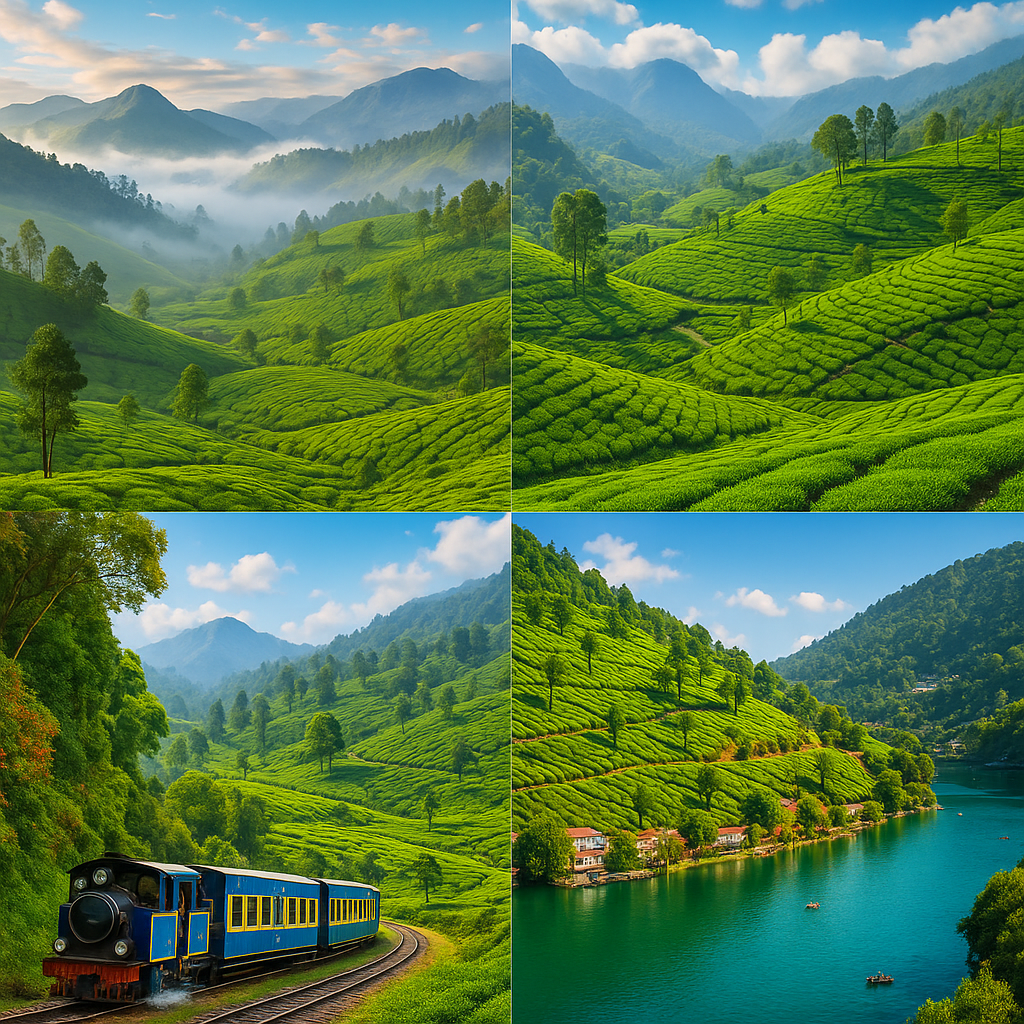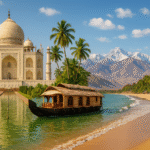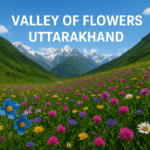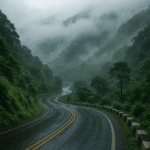India’s charm lies not only in its bustling cities and golden deserts but also in its hill stations — serene mountain towns perched high above the plains. These destinations, spread across the Himalayas, Western Ghats, and Eastern ranges, have historically been retreats for royalty, colonial officers, and now travelers from around the world.
Each hill station has a unique character: colonial architecture, tea and coffee plantations, ancient temples, lakes, valleys, or adventure sports. Whether you seek snow, misty forests, or cultural immersion, India’s hill stations offer the perfect escape.
Let’s dive deep into the most iconic, offbeat, and culturally rich hill stations of India.
🏔 North India: Himalayan Classics
Shimla, Himachal Pradesh
- History: Established as the summer capital of British India in 1864.
- Top Attractions: The Ridge, Mall Road, Christ Church, Jakhoo Temple, Kufri for snow lovers.
- Activities: Shopping, ice skating in winter, heritage walks, toy train ride (Kalka–Shimla UNESCO railway).
- Food to Try: Sidu (Himachali bread), Chana Madra, trout fish.
- Best Time: March–June (pleasant); December–January (snow).
- How to Reach: Nearest airport Chandigarh (113 km); Kalka–Shimla toy train.
Manali, Himachal Pradesh
- History: Ancient trade route town, now a hub for adventure tourism.
- Top Attractions: Solang Valley, Rohtang Pass, Old Manali, Hidimba Devi Temple.
- Activities: Paragliding, trekking (Hampta Pass, Bhrigu Lake), skiing in Solang Valley, river rafting in Beas.
- Unique Vibe: Backpacker cafes, hippie culture, adventure sports.
- Best Time: October–June.
- How to Reach: Bhuntar Airport (50 km).
Nainital, Uttarakhand
- History: Discovered by British in 1841, developed around the sacred Naini Lake.
- Top Attractions: Naini Lake, Snow View Point, Naina Devi Temple, Governor’s House.
- Activities: Boating, ropeway rides, shopping at Tibetan Market.
- Best Time: March–June (summer), September–October (autumn).
- Food: Bal Mithai, Aloo ke Gutke, Ras (local Kumaoni dishes).
- How to Reach: Kathgodam Railway Station (35 km).
Leh–Ladakh, Jammu & Kashmir
- History: Once part of ancient Silk Route trade; strong Buddhist influence.
- Top Attractions: Pangong Lake, Nubra Valley, Magnetic Hill, Hemis Monastery.
- Activities: Biking (Manali–Leh Highway), camping by Pangong Lake, trekking (Markha Valley).
- Festivals: Hemis Festival, Ladakh Festival.
- Best Time: June–September (roads open).
- How to Reach: Leh Airport; Srinagar–Leh or Manali–Leh highways.
🌲 North-East India: Mystical Hills
Shillong, Meghalaya
- Nickname: Scotland of the East.
- Attractions: Umiam Lake, Shillong Peak, Elephant Falls, Ward’s Lake.
- Culture: Rich Khasi heritage, love for music (Shillong is India’s “Rock Capital”).
- Activities: Boating at Umiam Lake, café hopping, trekking.
- Best Time: March–June, September–November.
- Food: Jadoh (rice and pork dish), Dohneiiong, Tungrymbai.
Cherrapunji, Meghalaya
- Attractions: Nohkalikai Falls, Seven Sisters Falls, Mawsmai Caves.
- Unique Feature: Home to living root bridges built by Khasi tribes.
- Activities: Trekking through rainforests, cave exploration.
- Best Time: October–May.
- Special Tip: Carry rain gear even in “dry” months!
Gangtok, Sikkim
- Attractions: Rumtek Monastery, Tsomgo Lake, MG Marg, Nathula Pass.
- Culture: Blend of Tibetan Buddhist traditions with modern city vibes.
- Activities: Ropeway ride, yak rides, paragliding.
- Festivals: Losar (Tibetan New Year), Saga Dawa.
- Best Time: March–June, September–December.
- Food: Momos, Thukpa, Phagshapa (pork stew).
Tawang, Arunachal Pradesh
- Attractions: Tawang Monastery (largest in India), Sela Pass, Madhuri Lake.
- Activities: Snow trekking, monastery visits, meditation retreats.
- Unique Culture: Tibetan Buddhist influence, Monpa tribe heritage.
- Best Time: March–June, September–October.
- How to Reach: Via Tezpur (Assam) by road.
🌿 South India: Western Ghats Wonders
Ooty, Tamil Nadu
- History: Developed as a British hill retreat.
- Attractions: Botanical Garden, Ooty Lake, Doddabetta Peak.
- Activities: Nilgiri Mountain Railway ride, tea estate tours.
- Best Time: March–June, September–November.
- Food: Ooty homemade chocolates, Varkey biscuits.
Kodaikanal, Tamil Nadu
- Attractions: Kodai Lake, Pillar Rocks, Bryant Park.
- Activities: Cycling, boating, night forest trekking.
- Unique Feature: Kurinji flower bloom (once every 12 years).
- Best Time: April–June, September–December.
Munnar, Kerala
- Attractions: Eravikulam National Park (Nilgiri Tahr), Tea Museum, Anamudi Peak.
- Activities: Plantation tours, trekking, wildlife spotting.
- Food: Kerala Sadya, appam with stew, Malabar biryani.
- Best Time: September–March.
Coorg, Karnataka
- Nickname: Scotland of India.
- Attractions: Abbey Falls, Raja’s Seat, Dubare Elephant Camp.
- Activities: Coffee estate stays, trekking, river rafting.
- Culture: Kodava warrior traditions.
- Best Time: October–April.
🌾 West India: Quick Escapes
Mahabaleshwar, Maharashtra
- Attractions: Venna Lake, Mapro Garden, Arthur’s Seat.
- Specialty: Strawberries & mulberries.
- Best Time: October–June.
Lonavala & Khandala, Maharashtra
- Attractions: Bhushi Dam, Tiger’s Leap, Karla Caves.
- Best Time: July–September (monsoon magic).
Mount Abu, Rajasthan
- Attractions: Dilwara Jain Temples, Nakki Lake, Guru Shikhar.
- Best Time: October–March.
✨ Offbeat Hill Stations
- Chopta (Uttarakhand): Trekking base, Mini Switzerland.
- Kausani (Uttarakhand): 360° views of Nanda Devi, sunrise point.
- Tirthan Valley (Himachal): Ideal for trout fishing & riverside camping.
- Araku Valley (Andhra): Coffee plantations, Borra Caves.
- Haflong (Assam): Assam’s only hill station, peaceful & scenic.
🕒 Best Time to Visit
- Summer (March–June): Shimla, Ooty, Coorg.
- Monsoon (July–September): Lonavala, Munnar, Cherrapunji.
- Winter (October–February): Manali, Auli, Tawang.
🧳 Travel Tips for Hill Stations in India
- Pack Wisely: Always carry layers – even in summer, nights can get chilly.
- Respect Local Culture: Many hill stations have tribal or monastic traditions. Dress modestly, especially near temples and monasteries.
- Book Early: Popular stations like Manali, Shimla, and Ooty get crowded during summer and holidays.
- Health Precautions: Carry medicines for altitude sickness if traveling to Ladakh or Tawang.
- Try Local Food: Each region has unique dishes — don’t miss them!
🌍 Final Thoughts
India’s hill stations are not just destinations — they’re experiences. Whether you sip tea in Munnar, ride the toy train in Ooty, trek in Chopta, or watch the stars in Ladakh, each hill town tells a story of history, culture, and nature.
From the colonial charm of Shimla to the tribal richness of the North-East, and from strawberry fields in Mahabaleshwar to snow-covered slopes in Auli, India’s hill stations promise unforgettable journeys.
So, pack your bags — the mountains are calling! 🏔✨
🌱 Responsible Travel Tip:
“When visiting India’s hill stations, reduce plastic waste, support local homestays, and respect local traditions. Choose eco-friendly transport options whenever possible.”





